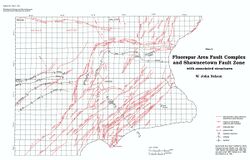McCormick Anticline
Location
Eastern Johnson and northern Pope Counties (J, K-6 and pl. 2)
References
Brokaw 1917, J. Weller 1940, Stonehouse and Wilson 1955, Potter 1957, Heyl et al. 1965, Jacobson and Trask 1983, Nelson et al. 1991, Nelson 1991
Description
The structure was first identified as an anticline and later shown to be faulted. It is defined by surface mapping, and several oil tests (all dry) were drilled on it. Recent, detailed surface mapping and seismic data add many details and suggest new interpretations of its origin.
The McCormick Anticline strikes northeastward in Johnson County and gradually curves to an east-west trend in northern Pope County. It reaches maximum relief of more than 700 feet (229 m) in Section 11, T11S, R5E, where small exposures of Kinkaid Limestone (Mississippian) are found at the crest. The surface rocks along the anticline are of Pennsylvanian age elsewhere. The north or northwest limb is steep and commonly has dips in excess of 30°. Dips on the southeast limb typically are gentle (fig. 49), less than 10°, although steeper dips have been measured in the vicinity of faults. The anticline plunges irregularly eastward and appears to die out as it approaches the Shawneetown Fault Zone. Southwestward in Johnson County, the fold appears to gradually die out, but faulting continues for several miles beyond.
The discontinuous faults mapped at the surface do not run the length of the anticline. Toward the east end of the structure, most faults strike east-northeast, slightly oblique to the fold axis. Westward the faults gradually change to northeastward strike, then almost north to south in southern Johnson County. The southeast side is downthrown on most faults, and displacements range from a few feet to more than 100 feet (30 m). Most faults apparently are high-angle normal. Potter (1957) reported low-angle thrust faults and large-scale sedimentary breccia in lower Pennsylvanian strata exposed in railroad cuts through the anticline in Sections 19 and 31, T11S, R5E. He interpreted these as evidence of large-scale slumping off the flanks of a structure that was rising during early Pennsylvanian sedimentation. Jacobson and Trask (1983) reported northwest-trending strike-slip faults, apparently offsetting northeast-striking faults in Johnson County. Continued study confirms the presence of strike-slip faults, but displacements greater than a few feet cannot be verified (Nelson et al. 1991).
A proprietary seismic reflection profile indicates that the McCormick and New Burnside Anticlines are "thin skinned" folds that do not involve basement. Reflectors near the surface are folded, but no folding was detectable on reflectors from Ordovician and deeper levels. The seismic profile also indicated reverse faults that dip southward and flatten with depth on both anticlines. These features suggest that compression from the southeast was transmitted along one or more dècollements in the middle of the sedimentary succession and produced the anticlines (fig. 50).
It has been postulated (Nelson 1987a, 1991) that the anticline developed under northwestward-directed compression during the late Paleozoic, and that normal faults formed during early Mesozoic extension.
See also NEW BURNSIDE ANTICLINE.


